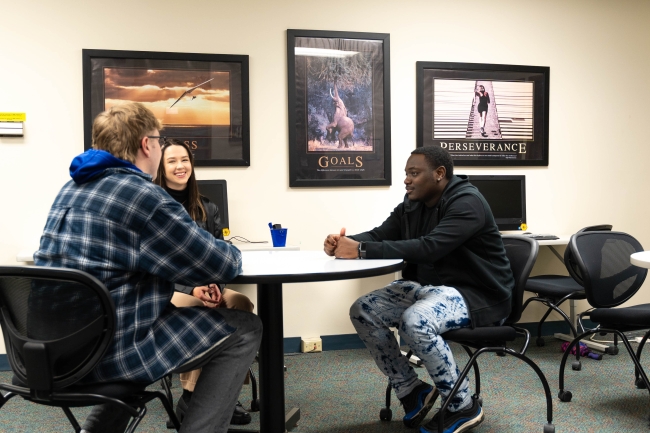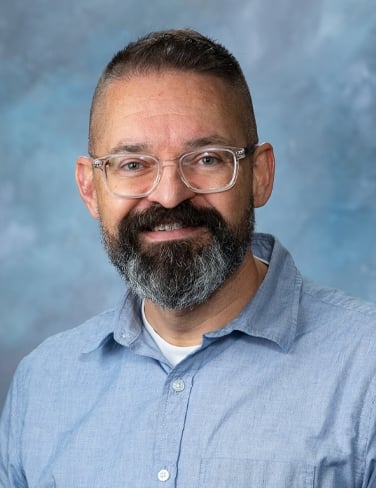You have /5 articles left.
Sign up for a free account or log in.

As the new vice president for student engagement, Christopher Waugh helps link co-curriculars with classroom learning.
St. Ambrose University
Christopher Waugh was first exposed to a career in higher education as an incoming residence adviser during his undergraduate program at Northern Illinois University.

St. Ambrose University
“It was maybe the third day of training that … it hit me, the intentionality of my residence hall experience. I had no idea how much care people were putting every detail,” Waugh says. “It was humbling.”
Waugh has served as the dean of students at St. Ambrose University in Davenport, Iowa, for the past five years, having previously worked at Pomona College in Claremont, Calif., as dean of campus life. He spoke with Inside Higher Ed about his recent promotion to vice president of student engagement and dean of students, his philosophy for student success, and strategic planning at the university.
Q: What is your new role and how does it fit with institutional goals?
A: When I arrived here, it was a pretty typical dean of students role: residence halls, counseling. I came right before COVID. Of course, everyone has their COVID stories.
The work has evolved, but then also we have a change in leadership. We have a fairly new president—[Amy Novak]—she’s going into her third year. She is so awesome, innovative and exciting, and she’s moving us in some really great directions. I’ve never had more fun at work than right now, actually, but I don’t think I’ve ever worked harder in terms of thinking and planning.
But the idea behind my new role is, previously there was a provost and vice president who oversaw two pretty big areas, Academic Affairs and Student Affairs. We’re not a giant university, so the person in that role was phenomenally gifted. As he retired, Amy, our new president, was very mindful that that’s not necessarily a position you can advertise for.
So that was a part of it, there was a practicality to the new role. The second piece was that Amy is really wanting to give front-line focus to how we plan for student success and all of the things that that’s going to need to look like in the next 10 years. The tenacity that will be required, and the care for adult learners who have families, traditional learners who live in the residence halls, folks who are wanting to come in for some certification and then hop back out and then maybe come back in a little bit later. And so, really having somebody to be able to truly focus on the complete student experience, on all of the different levels—transfer, commuter, etc.
I’m very excited to serve in this inaugural post. I would say this is a part of our leaders’ architecture of really emphasizing and prioritizing student success and student support.
Q: What new strategies is St. Ambrose considering for student success?
A: We’re really looking at a holistic approach. It’s not just student services that is doing this work but athletics, the classroom.
One of the strategic pieces that we’re working on is a more intentional program for the co-curriculum, and how do we link classroom learning with student organization experiences?
For instance, we have a marketing professor who works directly with our campus activities board, and the assignments in their marketing class are to market the student campus programming. It’s this really great blend of academic theory, married with real world application and the students assess their marketing strategies … We’re wanting to take that and really build that out and have that be more of a normative piece on our campus.
The other piece is, with the collaborative side, student services includes the residence halls, counseling, health services, student activities and leadership, international student support, the student success center, tutoring—these are pretty typical student success areas. But we also intentionally partner with campus ministry offices and with athletics. Both areas come to my leadership team meeting. They don’t report directly to me, but we recognize that work is so integral. The new provost and I, we attend each other’s meetings as well, because there’s an intentional link between what’s happening in the classroom and what’s happening outside of the classroom.
Q: What is the biggest challenge in student success work and creating a holistic student experience?
A: Probably the biggest challenge is the work that we’re doing is human, it’s not robotic. We tried a system that was essentially where students could click through for counseling … and our students just didn’t take to it. There’s really no replacing the eyeball-to-eyeball, person-to-person work that we do.
I think one of the biggest challenges is, how do we create opportunities for humans to be available on evenings and on weekends? And how do we then also be mindful of staff and faculty and their wellness?
Amy, our president, has been looking at very innovative ways to think about staff schedules, remote work and trying to build in some flexibility so that we can be free to be available to students when they need it.
I remember when I was a grad student, working on my last degree, I was married, had a full-time job. So for me, the 8-to-5 office, that didn’t work. It would have to have been weekend or evening for me, or I just wasn’t able to access the resource. We’re trying to kind of push those boundaries of the 8-to-5 workday but also not exhaust the team while doing it.
Some of the things that we’ve really been wanting to work on and have been launching over the last year, two years, in some cases. Our evening and weekend tutoring, which happens both in-person and online. Evening and weekend study tables, we’ve started with athletics.
We’ve also continued online counseling. We shifted to that during COVID, for obvious reasons. But we’re allowing that as a as a flexible piece. That works really well especially for adult learners and commuting students. We have also started a series of mindfulness groups in the residence halls. Our therapists are going to where students live and hosting groups.
Q: How do you define student success?
A: Student success is a student being able to engage with an institution in a way that’s meaningful to them, practical to them and affordable to them so that they can achieve the outcomes that they’re looking for. And hopefully, some outcomes that they weren’t looking for that add even more value.
I think student success in the future is going to be ongoing; I think higher education institutions will likely be lifelong partners, with students who will likely need to come back for a certain certification for something that they get in their career. Because the world of work is constantly changing, I think higher ed is going to need to be responsive. Actually, I would say more than responsive, I think we’ve got to be thinking ahead, about what are the needs going to be so that we can be there when they’re ready?
I’ve never worked at a faith-based university before. One of the things I love about working at a faith-based university is “meaningful” is a part of the fabric of what we’re doing and why we’re here. It’s in the ether and it is always a part of the conversation: “What is the meaning of this? What is the purpose? What is the higher idea?”
And then [practically], one of the things that our current president has really brought to us, this sense of awareness and urgency for our students need practical skills. Yes, it’s anchored in the liberal arts, and, yes, their English literature classes are going to inform, the, you know, quote, unquote, more practical work skills. That’s a part of what we offer. But we need to help them understand why being able to analyze a character in a novel is actually going to be helping them on a team that is problem-solving tomorrow’s biggest challenges.
The affordability piece is something I think that every university is looking at right now. And not only, what are the costs to the education, but how can we be more efficient? How can we be as effective with less resources?
I’ve worked at very well-resourced institutions and very modest institutions. When I’ve worked at institutions that didn’t have the financial resources, folks are very creative. And I like that, I really like being in that head space, because I think that it breeds innovation. I think that higher ed, as an industry, we need to be thinking about what are we spending our money on? Do we need to still spend it? Do we not?
Those types of efficiency pieces, I think, are essential, and higher ed has not ever really been saddled with that type of mind-set. I think there’s, in some ways, a laziness in thinking, presuming that everything that we’re doing is something we should be doing. I think that’s a luxury.
What excites me about moving ahead is really thinking critically about: Is what we’re doing still relevant to our students to help them achieve student success? Are there things that we should be doing that we should stop doing, and replace it or reduce it? I think the affordability piece is as much thinking about costs as it is thinking about efficiencies, and reductions and getting excited about the innovation that can come from them.
Seeking stories from campus leaders, faculty members and staff for our Student Success focus. Share here.




